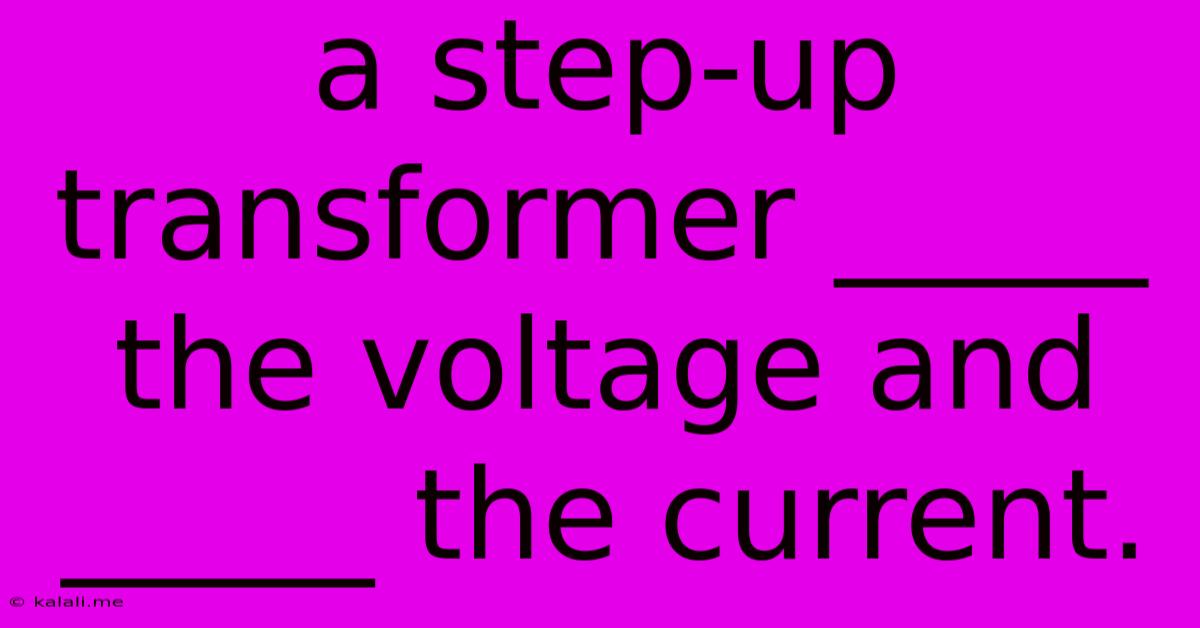A Step-up Transformer _____ The Voltage And _____ The Current.
Kalali
Jun 13, 2025 · 3 min read

Table of Contents
A Step-Up Transformer: Increasing Voltage, Decreasing Current
A step-up transformer is a crucial component in many electrical systems, playing a vital role in power transmission and distribution. Its primary function is to increase the voltage and decrease the current in an AC (alternating current) circuit. This article will delve into the mechanics of a step-up transformer, exploring its operation, applications, and the fundamental principles behind its voltage and current transformations.
Understanding how a step-up transformer works is essential for anyone working with electricity, from electricians to electrical engineers. The core concept lies in the relationship between the number of turns in the primary and secondary coils. By manipulating this coil ratio, we can effectively control the voltage and current output.
How a Step-Up Transformer Works
At its heart, a transformer uses electromagnetic induction. It consists of two coils of wire, a primary coil and a secondary coil, wound around a common ferromagnetic core. When an alternating current flows through the primary coil, it creates a fluctuating magnetic field within the core. This fluctuating magnetic field induces a voltage in the secondary coil.
The key to the step-up function lies in the number of turns in each coil. A step-up transformer has more turns in the secondary coil than in the primary coil. This difference in the number of turns is crucial.
-
Voltage Transformation: The voltage increase is directly proportional to the ratio of the number of turns in the secondary coil (N<sub>s</sub>) to the number of turns in the primary coil (N<sub>p</sub>). This ratio is known as the turns ratio. Mathematically, it can be expressed as: V<sub>s</sub>/V<sub>p</sub> = N<sub>s</sub>/N<sub>p</sub>, where V<sub>s</sub> is the secondary voltage and V<sub>p</sub> is the primary voltage. A higher N<sub>s</sub>/N<sub>p</sub> ratio results in a higher secondary voltage.
-
Current Transformation: While the voltage increases, the power remains relatively constant (ignoring minor losses). Power (P) is the product of voltage (V) and current (I): P = VI. Therefore, if the voltage increases, the current must decrease to maintain a roughly constant power level. This relationship is inversely proportional: I<sub>s</sub>/I<sub>p</sub> = N<sub>p</sub>/N<sub>s</sub>, where I<sub>s</sub> is the secondary current and I<sub>p</sub> is the primary current.
Applications of Step-Up Transformers
Step-up transformers are indispensable in various applications, most notably:
-
Power Transmission: High-voltage transmission lines use step-up transformers to increase the voltage to hundreds of kilovolts. This significantly reduces power loss during transmission over long distances, making efficient power delivery across vast geographical areas possible. This is a critical aspect of the national grid infrastructure.
-
High-Voltage Appliances: Certain appliances and equipment, such as X-ray machines and particle accelerators, require high voltages for their operation. Step-up transformers provide the necessary voltage boost.
-
Electrical Substations: These act as vital switching points within the power grid, and step-up transformers are integral to increasing voltage for efficient long-distance power transfer.
-
Laboratory Equipment: In research and development, step-up transformers are crucial in providing high voltages for specific experimental setups.
Efficiency and Losses
While transformers are highly efficient, some energy is lost during the transformation process. These losses primarily arise from:
-
Copper Losses (I²R losses): These are caused by the resistance of the wires in the coils. Higher currents lead to increased copper losses.
-
Core Losses (Hysteresis and Eddy Current Losses): These are related to the magnetization and demagnetization of the core material. Hysteresis losses are due to the energy required to re-magnetize the core, while eddy current losses result from circulating currents within the core itself.
In conclusion, the step-up transformer is a fundamental device that plays a significant role in modern electrical systems. By increasing voltage and decreasing current, it enables efficient power transmission and enables the operation of high-voltage equipment. Understanding its operation and applications is essential for anyone working with electrical systems.
Latest Posts
Latest Posts
-
Which Of The Following Statements Are True Regarding Explicit Memory
Jun 14, 2025
-
Which One Of The Following Statements Is Incorrect
Jun 14, 2025
-
Which Of The Following Is Not An Agent Of Socialization
Jun 14, 2025
-
Common Factors Of 56 And 84
Jun 14, 2025
-
Lcm Of 9 6 And 3
Jun 14, 2025
Related Post
Thank you for visiting our website which covers about A Step-up Transformer _____ The Voltage And _____ The Current. . We hope the information provided has been useful to you. Feel free to contact us if you have any questions or need further assistance. See you next time and don't miss to bookmark.